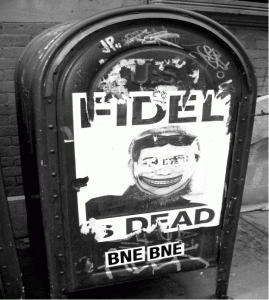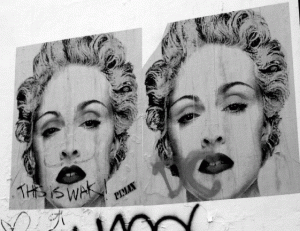Street art takes back public space for the public’s voice
By Carly Willsie
To break into a telephone booth’s advertising locations, you need three tools: a cordless drill, a magnetized bit extension and a tamper-proof bit set.
That’s the hard part. After that all you need to do is remove the screws on the edge, quickly pop out the JC
Penney Christmas Sale advertisement and put a cool piece of art in its place before getting caught by the police or some well-meaning tattle-tale. Jordan Seiler will tell you the same on his Web site for the Public Ad Campaign, an organization that promotes the redefinition of public space through street art.
After putting up an art print over an ad on the NYC subway on a whim, Seiler became interested in street art and its political implications, eventually founding the Public Ad Campaign in 2000.
“It put questions into my mind about what kind of imagery do I want to see in my environment? And who’s allowed to talk in my environment? It very quickly became obvious that the public voice is really not a part of public space,” says Seiler.
Street art refers to any art that occurs in the public arena – on buildings, telephone booths, mailboxes, benches and, of course, on the actual streets. It usually moves beyond graffiti tagging and into more conceptual artistic space, though the lines between graffiti and street art are tenuous. Street art began as an extension of graffiti and was eventually popularized by artists like Banksy and Shepard Fairey.
While street art’s subversive nature lends itself to political statement, not all street artists recognize their art as such, as Seiler mentioned.
“When people think about a political act they think that the statement has to make a political statement.
Not all street art does that…Some is very funny; some are very creative and beautiful. The political act is reclaiming public space,” says Marc Schiller, founder of Wooster Collective, a street art blog.
Not only does street art help to redefine a citizen’s relationship with public space, it also redefines the context in which the public views art.
“Art is very intimidating for so many people because art is what’s in a museum; art is in a gallery; art’s about a technique; it’s about Rembrandt and Van Gogh … We learn as kids that art is supposed to be something that’s very much for the elite … and here Banksy comes along and re-says what art is. Art is graffiti,” says Schiller.
A unique level of interaction emerges when art is thrust into the everyday: it is artistic dialogue between creator, consumer and cityscape. It encourages art to be considered as a part of life rather than a privilege of culture. It transforms pedestrian appreciation by high society to widespread appreciation by pedestrians.
Such redefinition is always met with resistance. Because of its illegal nature, many street artists choose to conceal their identities. Poster Boy, a New York-based artist, is notorious for his anonymity, refusing requests for interviews or contact information. Royce Bannon is likewise ignominious, having been arrested twice for his art.
“I don’t consider it vandalism because I took time to sit at home and draw these things and I don’t put them on somebody’s house or put them on a church. I’m very careful about where I put my stuff … usually it’s in a desolate area or somewhere downtown where there’s tons of art already. I’m kind of picky. I don’t want to destroy people’s property,’ says Bannon.
The risk of getting arrested is often outweighed not only by its own thrill, but also by the instinctive desire to leave a personal mark on one’s surroundings.
“These are people who have decided that it is important to them to define themselves on city walls … and the city has to realize that’s part of a condition of living in public space … You become alienated from your environment because there’s so many people here.You live in a space that doesn’t quite recognize you because there’s so many of us and some people feel the need to write on their walls,” says Seiler.
Street art, when it comes down to it, brings art into main street. I don’t know him or anything, but Barack Obama would probably be into it.
Carly Willsie is a senior journalism major who says, “Fuck tha police.” E-mail her at [email protected].


